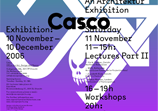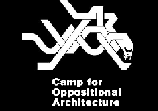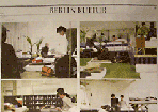back to list
Greenpepper Magazine, Amsterdam 9/2004
A Commentated Report on the Camp for Oppositional Architecture
Robert Burghardt
Space is an essential element of human existence, determining the way we think, how we translate possibilities, it talks about our being, our practice. Without doubt architecture, as the physical manipulation of space, has an important influence on how we act and who we are. And in return, the movement of our bodies erodes space, cuts traces, manipulates.
What positions are being concealed behind the above mentioned concepts? Opposition implies a position. What positions are there to call themselves oppositional within the field of architecture? Oppositional to what? Architects seem to have retracted from the realm of a public architectural discussion. The aim of engaging into society with architecture seems to have been replaced by the production of marketable logos and commodities for world-wide investors: image value.
The questions for the camp were formulated very clearly: "How to criticize the demands of a capitalist production of space? How to criticize this powerful contiguity?”. The political architectural journal An Architektur – who co-ordinated the congress - called people from the field of art, planning, theory and architecture to a disused factory site in the former working class district of Berlin Wedding to join the Camp for Oppositional Architecture. About 100 people from about 16 different countries followed that call and found their way to the former Rotaprint site which proposed a very inspiring setting to the conference. The complex was a very curious example of post-war reconstruction. Remainders from the pre-war production facilities (such as classic Berlin backyard factory buildings) mix up and intersect with very ambitious post-war structures (such as provocative and crude concrete towers) throughout the site. The ‘lecture hall’ and the spaces for the working groups were in a low-rise building with generous window fronts giving the event a very airy and open feeling. Architecture students designed a sleeping landscape in one of the former production halls.
Exploring oppositional space
The event was launched with a series of lectures to give indications of what oppositional architecture might be: Simone Hain, an engaged architectural and art historian from Berlin, lectured about the forgotten and progressive aspects in the practice of Hannes Meyer, the last director of the Bauhaus: collective, anonymous and interdisciplinary design, the refusal to establish intellectual property, and the importance of being an attentive observer as well as taking the working conditions of those who produce the built environment into account. She hinted at something that has drowned in the bureaucratic, economised leftovers of the modern movement. Bryan Bell, an architect from North Carolina, USA, reported on projects he did with migrant workers and poor communities. Bell involved the future users very closely into the design process, using cheap and recycled materials to build structures such as housing on farms for precarious fruit-picking labourers. Finally Roemer van Toorn from the Dutch Berlage Institute delivered a moderate critique of the contemporary architectural condition by unmasking what he called ‘fresh conservatism’. In this position, conservative values - sexism, social darwinism, elitism etc. - are packed into a hip and fresh visual language within the high-tech mediascape: young, free, attractive and on the sunny side. He proposed not to be ambivalent, but to practise a liberating or progressive directionality. This seemed to be an important statement.
Architects actually produce images and they should beware what these images mean. In that same way they are victims of these images themselves: the flexible, networking, high-technology using, up-to date, life-long learning, self-responsible producer. The creative person as a role model for the deregulated society: everybody as everybody’s competitor in a no-win game. Very clearly the modes of production are directly related to the kind of architecture that is being produced. Market pressure demands ‘market compatible buildings’. This leaves little space for either experimentation, reflection on the effects of what you do, or an engaged public dialogue.
How else could we imagine a mode of production in a spirit of solidarity? This was one of the questions that were discussed in a series of workshops that were at the core of the conference. The organisers filtered three main clusters of questions from the interest statements of the participants:
1. Oppositional social engagement: how can we grasp and relate to contemporary social reality?
2. Oppositional Design Concepts: how can we imagine and design critical forms and architecture?
3. Oppositional Strategies of Interventions: how can we reflect on and intervene into the built environment.
In a search for commonalities the workshops functioned basically as a space to scan each others positions, to formulate more specific questions, and to start some possible working processes.
After a very exhausting day Peter Marcuse, Professor for Planning at the Columbia University, arrived to bring the discussions back to the point: “I do not want to speak about what is wrong (growing inequality within and amongst countries) that is clear, I would rather like to speak about what can be done about it”. Marcuse proposed two possibilities: the choice for whom and whose interests you work and the implementation of an oppositional position from which to argue and operate.
Possible intersections
It was left to the participants of the camp to answer that question for themselves. The next day was used to sketch a few approaches. Many old and classic questions and proposals appeared: Should we change the system from without or within, should we go into the industry and subvert it? Should we form a union, build a community? Build networks? Engage with the general public?
Finally a charter for oppositional architects was produced – albeit in provisional draft form. It was both an attempt to summon up the do's and don'ts of the oppositional architect and a means to take a stand on these issues rather than remain in ambivalence. The charter reads like a pretty religious set of rules, but it is an important way of keeping an ongoing process and fixing positions to relate to. It is a very useful tool to define an outspoken oppositional position that can engage public debate about architecture and space - an oppositional architecture that can transform into emancipative social change and use its language to push the border of collective imagination to propose different ways of making society.
The aim of the conference was about finding point of intersection and checking whether there is potential to form a common oppositional position. The invitation policy was very open and the call for the conference was distributed widely amongst different groups outside the fields of architecture, planning and design. Some of the working groups were pretty fruitless, with too many questions opened and the realities positioned too far from each other. But by the end of the congress a starting-point for a potentially powerful platform had been created and sites for building further on that platform were proposed. The next camp for oppositional architecture was tentatively planned to be held in Glasgow, Scotland sometime in 2005.
 Camp 2009
Camp 2009 Camp 2006
Camp 2006 Camp 2004
Camp 2004 Charter
Charter Press
Press